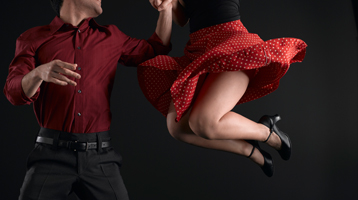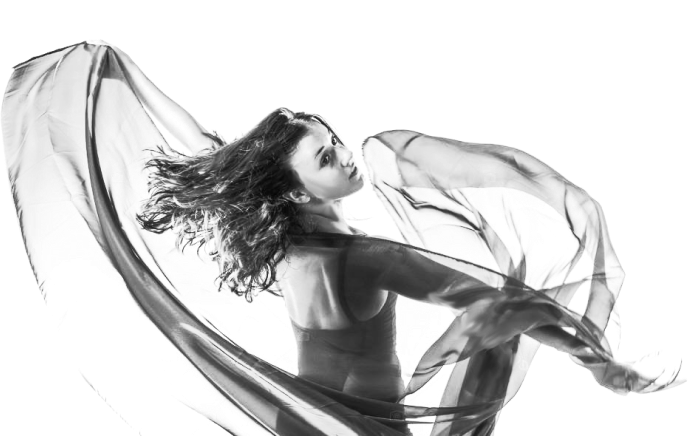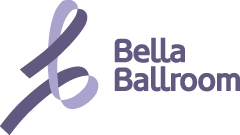
Swing Dance
Lindy Hop
Referred to as the “original” swing dance, the Lindy Hop has been enjoyed by many generations of dancers. It is characterized by fast rotations, swing outs and high-energy footwork. The Lindy Hop is the most iconic style of swing dancing and some consider it to be as popular today as it was in the 1930s.
History of Lindy Hop:
Lindy Hop swing dancing began in the 1920s and 30s in Harlem New York. Jazz music had become extremely popular in the United States during this time, and dance fads emerged as a result. Like most developed dances, Lindy Hop was born from the influences of a variety of dance styles. The Charleston and Tap were two of the popular jazz dances that heavily influenced Lindy Hop. The early stages of the Foxtrot were also included in Lindy Hop’s original styling. Lindy hop also grew from the blending of African rhythms and movements with European structured dance partnering. Remnants of older dances such as the Black Bottom, Cakewalk, Texas Tommy, and animal dances such as the Turkey Trot and Buzzard Lope influenced the Lindy Hop structure and movements.
Ballrooms dominated Harlem in New York City during the 1920s and 1930s, but there was only one that became famous for hosting swing dancing. The Savoy Ballroom became the place where Lindy Hop was fine-tuned, given a home base, and able to evolve. It was here that the “Savoy style” of Lindy Hop evolved. The Savoy was a very large ballroom. It took up an entire block at 141st Street and Lenox Ave. The Ballroom was very inspiring for dancers and was one of the few ballrooms at the time that allowed racial integration. The Savoy hosted 70,000 dancers a year and became known as the “home of happy feet.” The ballroom had an elongated shape with sprung floors that needed to be replaced every three years. A bandstand at each end of the ballroom allowed for two live bands to play every night, 7 days a week!
Lindy Hop social dancing became extremely popular. A night out dancing was affordable and Jazz fans were happy to go out to hear live music by big names such as Duke Ellington, Cab Calloway, and Count Basie especially since recorded music was not yet readily assessable. The musicians and the dancers would feed off of each other’s energy and improvisations making for a magical, spontaneous, and fun time. Dancers happily compared moves, participated in weekly friendly competitions, and invented new creative moves, including Aerials and lifts.
As Lindy Hop boomed, dance marathons became very popular and it’s because of one of them that Lindy Hop got its name. In 1927, Charles Lindbergh was going to take the first solo flight from New York to Paris. People were fascinated with Lindbergh’s “hop” across the Atlantic. At the time there was a great swing dancer by the name of George “Shorty” Snowden. He was at the end of a long dance marathon when a reporter watching asked what the crazy dance he was doing was called. He answered with a quick-witted response saying it was the “Lindy Hop.” The name stuck and is still called as such today. The Lindy Hop is considered to be the “first” swing dance and has inspired many of the other swing dance styles that came after it.
Lindy Hop Swing Dance Today:
Lindy Hop dancing is very much alive and celebrated today. Lindy Hoppers are known for their fun energy, down-to-earth sprit, and ability to have a great time. There are thriving Lindy Hop communities throughout the world and Lindy Hop can be found in nearly every large Westernized city.
In Orange County and Los Angeles, there are many mainstream venues that host Lindy Hop dancing. Many of these venues have no cover charge. The Disney resort in Anaheim hosts swing dancing at Downtown Disney and often hosts live bands playing danceable music inside the park as well. Expensive hotels, fancy bars, and restaurants are also known to host Lindy Hop and swing dancing. Joe’s Bar, the Culver Hotel, Rusty’s Rhythm Club, the Santa Monica Pier and Viva Cantina are a few venues in Southern California that host Lindy Hop music and dancing.
Lindy Hop dancing is also hosted at dance camps and dance competitions around the world. The small village of Herrang in Northern Sweden has unofficially become the international mecca of Lindy Hop because of their annual Herrang Dance Camp. Dancers from around 40 different countries attend this camp. This is one example of how Lindy Hop is celebrated on an international scale, in addition to being popular in smaller concentrated local city scenes. Lindy Hop dancers gather and interchange dance ideas and moves through the concept of Lindy exchanges on both local and international levels.
Lindy Hop today is a social dance, a competitive dance, and a performance dance. Lindy Hoppers may dance alone or together and often use improvisation as a central theme when dancing. Lindy Hop’s upbeat and fun nature have allowed the dance to persevere and continue to be extremely popular throughout the world.
Lindy Hop Music:
- “All Shook Up” Elvis
- “Regular Joe” Indigo Swing
- “Wade in the Water” Eva Cassidy
- “Five Minutes More” Frank Sinatra
- “My Same” Adele
- “It Ain’t the Meat” Dana Gillespie
- “Stompin at the Savoy” Benny Goodman
- “Things Ain’t What They Used To Be” Charlie Barnet
- “Let It Roll Again” Nix Glover
- “On the Sunny Side of the Street” Ella Fitzgerald & Count Basie
- “Sing, Sing, Sing” Gene Krupa
- “One O’clock Jump” Count Basie
- “Stompin’ at the Savoy” Sonny Burke
- “For Dancers Only” Jimmie Lunceford
- “Jive at Five” Jo Jones
- “Shake Rattle and Roll” Big Joe Turner
- “Jumpin’ Jive” Ray Gelato
- “Rockin’ Robin” Bobby Day
- “Doin’ That Lindy Hop Dance” New Orleans Moonshiners
- “It Don’t Mean a Thing” Ivie Anderson & The Duke Ellington Orchestra
- “Dig It” Doris Day and Les Brown
- “Miss Brown to You” Billie Holiday
- “Swingin’ on Nothin” Jonathan Stout & his Campus Five feat. Hilary Alexander
- “Bugle Call Rag” Benny Goodman
- “Sugar Blues” Clyde McCoy
- “When the Saints Go Marching In” The New Orleans Jazz Band
- “Jumpin’ at the Woodside” Lester Young & Count Basie
- “Sugar Foot Stomp” Members of the Benny Goodman Orchestra
- “Shout, Sister, Shout!” Lucky Millinder feat. Sister Rosetta Tharpe
- “Cole Slaw” Louis Jordan
- “Crazy Little Thing Called Love” Queen


